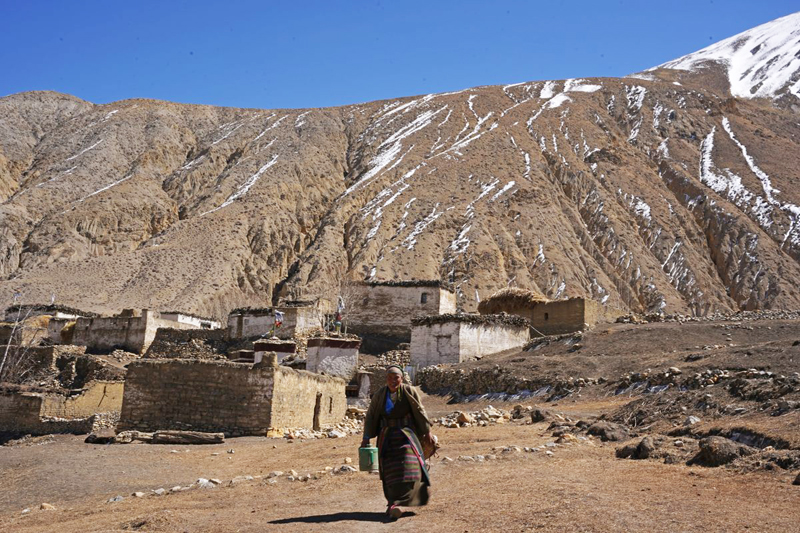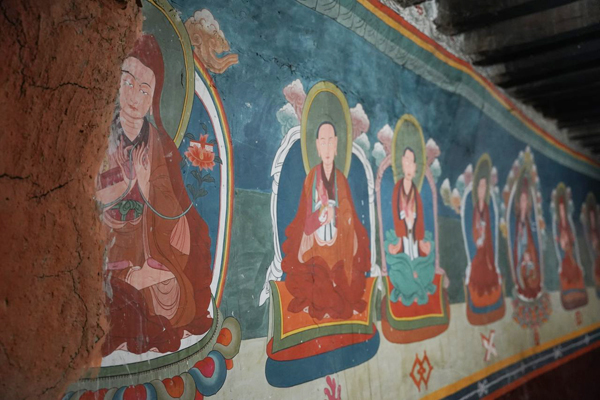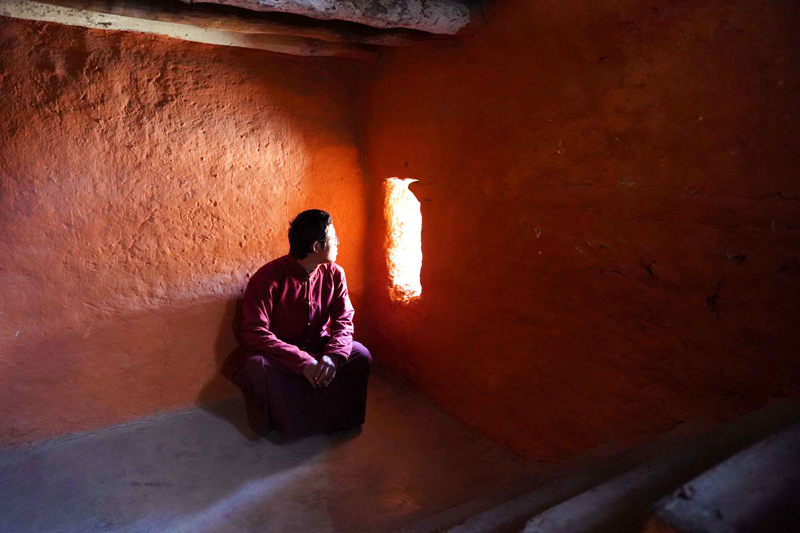The 15th-century Chhode monastery is tucked into a side valley of remote Mustang, a district in northern Nepal. The monastery, with walls formed of clay and gravel, blends in with the wind-beaten cliffs; its towering roof is held up by wooden pillars.
 Inside the monastery, a monk is performing a ritual prayer ceremony before a crowd of crimson-robed devotees of Tibetan Buddhism. The sound echoes within the crusty earthen walls. The dome-shaped ceiling is covered with paintings of fearsome creatures with fangs and turquoise skin which represent the protector deities.
Inside the monastery, a monk is performing a ritual prayer ceremony before a crowd of crimson-robed devotees of Tibetan Buddhism. The sound echoes within the crusty earthen walls. The dome-shaped ceiling is covered with paintings of fearsome creatures with fangs and turquoise skin which represent the protector deities.
Chhode is one of the last learning centers of the Sakya lineage of Tibetan Buddhism. The monasteries also create the tourism revenue that helps sustain the Indigenous community.
But the monasteries that have stood through centuries are now crumbling. Experts say drastic climate change is to blame and that other earthen structures may succumb to a similar fate if urgent measures aren’t taken for preservation.
The roofs of the Chhode monastery have begun to leak. The sacred art inside, which has existed undisturbed on the walls for over 500 years, is now flaking and may be lost forever as rising dampness peels paint and plaster from the mud walls.
 The rammed-earth technique used to construct the Chhode monastery is common throughout the region, and locals have lived in rammed earth houses for centuries.
The rammed-earth technique used to construct the Chhode monastery is common throughout the region, and locals have lived in rammed earth houses for centuries.
This traditional building method “compresses locally available clay, sand, gravel into vertical molds to construct walls. The materials are locally available and are cheap and have provided comfort in the cold and harsh region for centuries, perfect for the Himalayan environment.
 But storms and rainfall have increased in intensity across the region in recent years. The unpredictability of the rainfall combined with the rising temperatures presents a constant threat to these structures. More rain here also means the rammed earth gets saturated. Roofs begin to leak. Rising damp pulls moisture from the wet ground up into the walls.
But storms and rainfall have increased in intensity across the region in recent years. The unpredictability of the rainfall combined with the rising temperatures presents a constant threat to these structures. More rain here also means the rammed earth gets saturated. Roofs begin to leak. Rising damp pulls moisture from the wet ground up into the walls.
With road access and cheaper construction costs, many inhabitants are already rebuilding and repairing their dwellings using cement which is imported from China.
But studies show that when combined with traditional earthen architecture, cement disintegrates and cracks rapidly due to the difference in temperature between day and night, winter and summer.
 Loss of venerated traditions and tangible heritage can profoundly affect isolated and close-knit communities. For the Buddhists, the paintings in the monasteries are embodiments of the gods themselves, and they can’t worship a half-damaged idol. It is the monastery that people come to for spiritual safety and well-being but now it appears as though the monastery needs protection from this faceless man-made enemy.
Loss of venerated traditions and tangible heritage can profoundly affect isolated and close-knit communities. For the Buddhists, the paintings in the monasteries are embodiments of the gods themselves, and they can’t worship a half-damaged idol. It is the monastery that people come to for spiritual safety and well-being but now it appears as though the monastery needs protection from this faceless man-made enemy.
You can read the original article at www.atlasobscura.com
I might add a postscript to this article that another more durable technology that the Nepalese could employ is earthbag construction, and there are many examples of this existing in that country now, as we have shown in this blog over many years.
